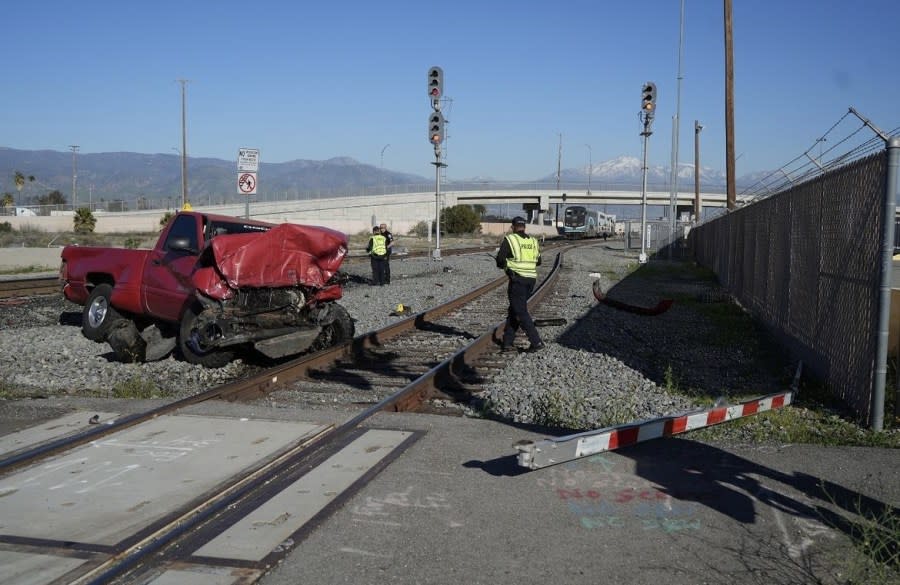Feds award $1.3M to Metrolink for trespasser detection technology possibly powered by AI

Metrolink has been awarded $1.3 million from the U.S. Department of Transportation as it explores new technology that would detect an intrusion on its tracks by using either artificial intelligence or new light and sensor technology.
The financial infusion is made possible as part of DOT’s Strengthening Mobility and Revolutionizing Transportation (SMART) grants program, which aims to improve transportation efficiency and safety across the country.
Metrolink says it will use the money, as well as additional grant funding secured in Congress, to develop and test a new “intrusion detection system” that will alert train operators about unexpected obstacles on the tracks, including both objects and people.
Between July and December 2023, Metrolink says 53 vehicle and pedestrian strikes occurred on its service lines — which are used by both passenger rail and freight operators. That represented a 39% increase compared to the same time period the previous year.
The majority of those strikes were ruled suicides, according to Metrolink, highlighting a continuing struggle facing both the nation and transit systems alike.
In Metrolink’s case, the growing number of unhoused individuals that often live along its right-of-way have often contributed to “unsafe behaviors near train tracks,” officials said.
The intrusion detection system would hopefully reduce the number of train strikes, saving lives and keeping trains and vehicles moving.
Copper thefts wreak havoc on Metrolink system, causing overlooked issues for public
How the system is developed isn’t entirely sorted out just yet. Metrolink said it will explore the use of AI-enabled cameras and radar, or light detection and ranging sensors that work in conjunction with its existing safety detection system, Positive Train Control (PTC).
The PTC system is a GPS-based safety technology that uses video and audio information to notify train crew members when a train must be slowed or stopped due to potential hazards.
The new intruder detection system would help PTC validate track intrusions, including trespassers, vehicles, large objects and other debris, Metrolink says.
Paul Krekorian, president of the Los Angeles City Council and a Metrolink board member, said safety at the passenger rail agency is “fundamental” and the innovative pilot project reflects that commitment.
“If it succeeds, this project will not only improve the safety of our passengers and crew, it will directly benefit pedestrians, cyclists, drivers and everyone else who interacts with our system,” Krekorian said.
How Metrolink is fighting human trafficking
During the project’s initial phase, the new intruder detection system will be deployed primarily with a 1.5-mile stretch of Metrolink’s Ventura County Line in Van Nuys, which has been a problem area for quite some time with track intruders and copper thefts causing significant issues throughout the Metrolink system.
Metrolink was the first passenger rail service in the U.S. to incorporate the PTC system and CEO Darren Kettle said they are always exploring and looking to incorporate new technology that would make the system safer.
“Looking ahead, the proposed track intrusion detection system could be modified for use by other passenger and freight railroads, dramatically increasing rail safety throughout the nation,” Kettle said in a news release.
SMART grants are awarded in two phases, according to Metrolink officials. Stage 1 funding is intended to help with the planning and prototyping of transit improvement projects. If those projects prove to be viable, they may be selected for a Stage 2 award with a cash infusion of as much as $15 million to implement the project elsewhere.
While advancing technology is promising, it’s only one part of the equation. Metrolink is also utilizing more traditional methods for reducing train strikes and vandalism, including working with law enforcement partners, community groups and research institutions to increase patrols in high-strike areas, remove homeless encampments and help those struggling with mental health challenges find appropriate resources.
With more than 540 miles of service line and dozens of stations across Southern California, stopping train strikes and preventing unnecessary deaths is a major win for the region.
For the latest news, weather, sports, and streaming video, head to KTLA.



